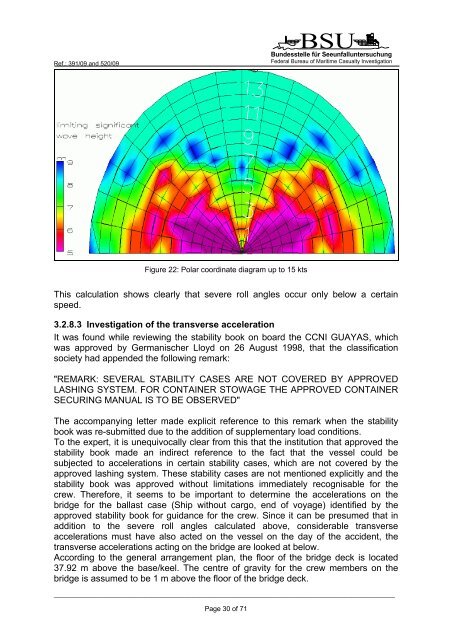SUB-COMMITTEE ON STABILITY AND LOAD LINES AND ON ...
SUB-COMMITTEE ON STABILITY AND LOAD LINES AND ON ...
SUB-COMMITTEE ON STABILITY AND LOAD LINES AND ON ...
You also want an ePaper? Increase the reach of your titles
YUMPU automatically turns print PDFs into web optimized ePapers that Google loves.
Ref.: 391/09 and 520/09<br />
BSU<br />
Bundesstelle für Seeunfalluntersuchung<br />
Federal Bureau of Maritime Casualty Investigation<br />
Figure 22: Polar coordinate diagram up to 15 kts<br />
This calculation shows clearly that severe roll angles occur only below a certain<br />
speed.<br />
3.2.8.3 Investigation of the transverse acceleration<br />
It was found while reviewing the stability book on board the CCNI GUAYAS, which<br />
was approved by Germanischer Lloyd on 26 August 1998, that the classification<br />
society had appended the following remark:<br />
"REMARK: SEVERAL <strong>STABILITY</strong> CASES ARE NOT COVERED BY APPROVED<br />
LASHING SYSTEM. FOR C<strong>ON</strong>TAINER STOWAGE THE APPROVED C<strong>ON</strong>TAINER<br />
SECURING MANUAL IS TO BE OBSERVED"<br />
The accompanying letter made explicit reference to this remark when the stability<br />
book was re-submitted due to the addition of supplementary load conditions.<br />
To the expert, it is unequivocally clear from this that the institution that approved the<br />
stability book made an indirect reference to the fact that the vessel could be<br />
subjected to accelerations in certain stability cases, which are not covered by the<br />
approved lashing system. These stability cases are not mentioned explicitly and the<br />
stability book was approved without limitations immediately recognisable for the<br />
crew. Therefore, it seems to be important to determine the accelerations on the<br />
bridge for the ballast case (Ship without cargo, end of voyage) identified by the<br />
approved stability book for guidance for the crew. Since it can be presumed that in<br />
addition to the severe roll angles calculated above, considerable transverse<br />
accelerations must have also acted on the vessel on the day of the accident, the<br />
transverse accelerations acting on the bridge are looked at below.<br />
According to the general arrangement plan, the floor of the bridge deck is located<br />
37.92 m above the base/keel. The centre of gravity for the crew members on the<br />
bridge is assumed to be 1 m above the floor of the bridge deck.<br />
_____________________________________________________________________________________________________<br />
Page 30 of 71
















